Grazing cover crops can be a cost-effective way to achieve multiple productions goals. Cover crops can provide ground cover to prevent erosion, improve soil health over time, and provide nutrition to beef cattle. However, cover crops are not a fool proof feed. Turning cattle out onto cover crops to graze without proper feed tests can lead to a wreak due to improper management. Recently, I had a producer lose 12 head of growing cattle to polioencephalomalacia, a neurological disease in cattle consuming too much sulfur. After the incident, that producer wanted to test his cover crops to ensure he did not experience another tragic loss. My advice, is to test cover crops before grazing for protein, energy value, minerals, nitrates, and under some circumstances, prussic acid to ensure proper management and prevent undue losses. These are the 6 cautions to consider when grazing cover crops:
- Nitrates
Cover crop mixes include several plant species known to accumulate nitrates for example: brassicas, such as turnips and radishes, or small grain plants, such as oats, millet, or grain sorghums. When cattle consume high nitrate feeds, the microbes in the rumen convert that nitrate to nitrite. The nitrite is then in the gas, which the cattle belch and then inhale. The nitrite then binds to the blood hemoglobin preventing oxygen from binding. At levels between 1,400 – 2100 ppm NO3-N this can cause spontaneous abortions with no warning signs or symptoms. At levels between 2,100 – 4,000 ppm NO3-N sudden death may occur and therefore, animals grazing cover crops should be slowly acclimated to consumption of nitrates and offered a low nitrate roughage to fill up on first. Never allow hungry cattle onto a high nitrate field. Nitrate levels above 4,000 ppm NO3-N should not be grazed as sudden death will likely occur.
- High sulfur
The toxic level of sulfur in a cattle diet is 0.40 ppm on a dry basis. Brassicas are sulfur accumulators, that occasionally test above the maximum tolerable level, and are often included in cover crop grazing mixes. When sulfur intake is above the tolerable level, thiamin metabolism is impaired in a condition known as polioencephalomalacia (PEM). Head pressing, blindness, and muscle tremors are all clinical symptoms of PEM which, untreated, results in death.
- Low magnesium
Grass tetany is a condition commonly associated with lush spring pastures. These pastures are known for having low magnesium due to rapid growth conditions. Cover crops also tend to have low magnesium. The magnesium requirement for a beef cow is 0.2% of the diet at peak lactation and 0.1% of the diet for growing cattle. When cover crops contain less magnesium than is required, a magnesium deficiency can develop resulting in grass tetany. The signs of grass tetany are cattle stop grazing, become overly alert, and appear uncomfortable, they will then begin to stagger until they finally lie down with their head pulled back into a “star gazing position”. Untreated, this condition will result in death. To prevent the development of a magnesium deficiency, many producers grazing cover crops feed a mineral between 8-12% magnesium to be consumed at a rate of 2.5-4oz per head per day.
- Prussic acid
In cover crop mixes there are species of plants which accumulate hydrogen cyanide, a poisonous gas commonly known as prussic acid, in their leaves under stressful growing conditions. These plants include sorghum grasses, sudan grasses, and flax. Stressful growing conditions includes drought or frost. Plants grown in drought conditions should be tested for prussic acid prior to grazing because consumption of high levels of the gas is sudden death. Contrarily, frost typically breaks cell walls allowing the release of the gas and therefore should be safe to graze after 4 days. Regrowth after a frost however, should be tested prior to grazing because the plant is stressed from the previous frost, but the cell walls have not been broken to allow the gas to escape.
- Bloat
A frothy bloat is often attributed to legumes or high protein grasses. Cover crop mixes high in legumes such as clover, beans, or cowpeas may result in some animals over indulging in the legumes resulting in frothy bloat issues. These legume plants are high in soluble protein and sugars which allows the microbes to ferment and grow at a rapid rate resulting in a high rate of gaseous by-product accumulation.
- Choke
Brassicas such as radishes and turnips may be pulled from the ground to be consumed by cattle grazing cover crops. If they are swallowed without proper mastication the animal may choke on the large root. This is typically more of a problem for young cattle who are inexperienced in grazing brassicas.
Overall, grazing cover crops can be a great way to provide nutrients to cattle, prevent soil erosion and improve soil health. However, the producer should be aware of the risks they are assuming feeding these diverse forages. Testing for nitrates, minerals, and potentially prussic acid is highly recommended to avoid unnecessary losses due to grazing cover crops.

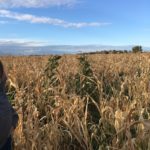
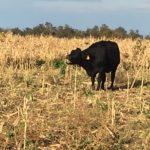
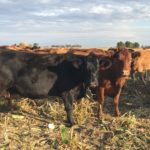
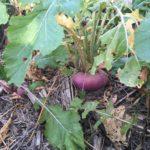
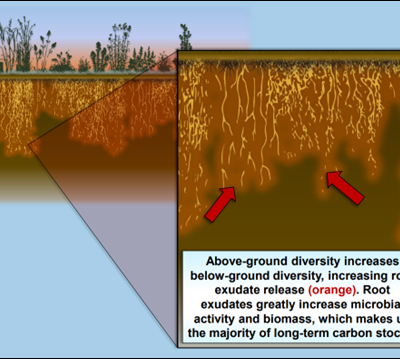
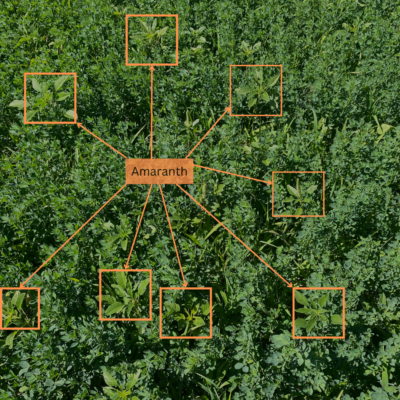
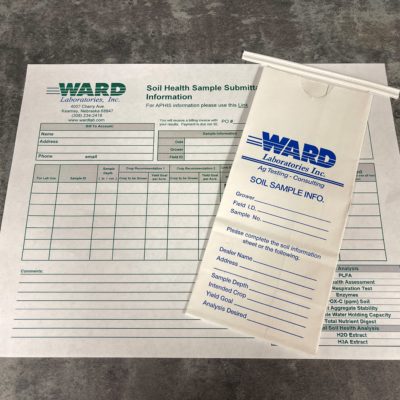

[…] Integrating cropping systems with forage production and grazing benefits soil health, grazing livestock, and your pocketbook. Grazing cover crops specifically benefits beef production by extending the grazing season, thereby saving on winter stored feed costs, improving the animals nutritional plane resulting in improved animal performance through increased intake and gains, and bonus regrowth can also be grazed, again saving on winter feed costs. Don’t forget to take proper precautions before allowing cattle to graze cover crops. See my blog post: 6 Cautions When Grazing Cover Crops. […]
[…] or wheat stubble check for nitrates before letting animals out in the field. And revisit my blog 6 Cautions When Grazing Cover Crops to ensure you are feeding a safe forage when grazing cover crops. For more information on drought […]
[…] have covered nitrate toxicity in other blogs including: Do I Need to Test for Nitrates?, 6 Cautions When Grazing Cover Crops, and 4 Considerations for Feeding Hail Damaged Forage and Crop Residues. So, for testing nitrates in […]